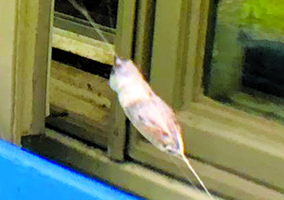Wily Webs

One of the signs of fall in my garden is not usually easy to see but you know it when you walk into it. Spider webs and spider traps.
Most mornings I now take a walk carrying a long stick so I can easily relocate the garden spiders setting up their sticky traps close to my bee hives; pretty smart if you think about it. Bees flying in and out get caught in the webs and once wrapped in silk, are ready food for baby spiders once they hatch.
Missouri is home to more than 300 kinds of spiders, 22 of those unique species. Spiders, ticks, mites and scorpions are all arachnids, not insects.
They have 8 walking legs with tiny retractable claws on each foot. Most have 6-8 eyes on top of their heads, which provides them with great depth perception and the equivalent of 3-D vision. Spider bodies are two-piece and hairy. Some sit in their webs waiting for meals to walk by, others actively chase prey.
Only two are considered dangerous to humans: the brown recluse and the female “black widow,” both very small spiders. The rest are harmless. I did get a spider bite when one was in a shoe a couple of months ago. Besides some redness and itching, it was similar to a bee sting; no harm done. Well, except to the spider. I did inadvertently squish it.
As I look for webs in my garden, I find some that are just strands of silk while others remind me of delicate lace. Garden spiders build beautiful lacy-like webs with a center zigzag patterns. Crab and orbweaver spiders build large web circles. Orbweavers have large stomachs and hairs on their legs and tummy. They also sit in their webs with their heads up.
Another common spider in my garden is smaller and dark with white markings, most likely micrathena. They range in color from pale yellow to white with dabs of brown or black and grow to be 8-10 mm in size. I find them hanging with the top of their bodies hanging downward.
There are also several tiny spiders with what appears to be trap lines stretched across bushes. I am still working on identifying the smaller ones.
As a fan since childhood of E.B. White’s “Charlotte’s Web,” spiders hold a special place in my garden but they are also important biological control agents. They feed on common insect pests including aphids, caterpillars, leap hoppers, mosquitos and flies. It was estimated arachnids consume 400-800 million metric tons of prey each year and more than 90% are invertebrates. According to Lund University, “spiders eat more insects than people eat meat and fish.”
This time of year black and yellow garden spiders are prominent, at least in my garden. The females are up to four times larger than the males and much brighter in color. These are the ones I keep re-locating. Their main diet consists of insects like flies and bees. Haven’t tried them on curds and whey.
Charlotte Ekker Wiggins is a beekeeper, gardener and sometimes cook. Published by El Dorado Springs Sun with author’s permission. Copyright 2018, all rights reserved. Contact Charlotte at gardeningcharlotte@gmail.com with your questions and comments.

BEE TRAP – A garden spider set up a web near my tiny waterfall and caught eight honeybees in her web.

CAPTURED BEE – This honeybee was caught in a spider web and wrapped up for a later meal source. (Photos by Charlotte Ekker Wiggins).



Facebook Comments